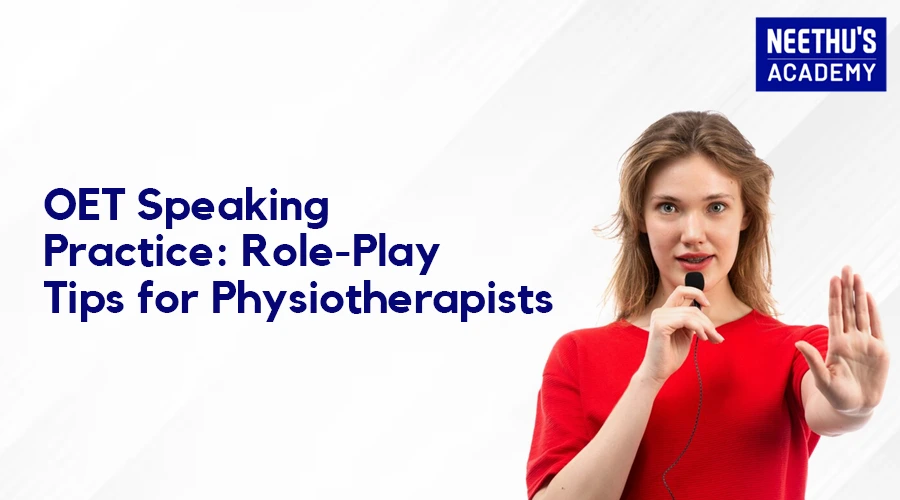OET Speaking for Doctors: Effective Communication and Role-Play Strategies
A successful medical practice relies heavily on effective communication, and, for doctors looking to find employment in English-speaking countries, the OET Speaking subtest is an integral part of that. It tests how well you can interact with your patients, explain medical concepts, and show empathy all in a structured, professional manner.
For many doctors, the OET Speaking subtest is challenging, especially with the role-play scenarios in real life for OET doctors. But with the right preparation and understanding of OET speaking techniques, you can shine and show off your ability to provide patient-centered care in English. In this blog, we will break down the speaking test, go over the structure, and share some tips to help you get good results with confidence.
Overview of the OET Speaking Test for Doctors
Why is OET Speaking Important for Doctors?
Effective communication is just as important as medical knowledge The OET Speaking subtest evaluates your ability to communicate professionally and empathetically with patients, which means safety and trust. Some of the most important reasons why OET Speaking for doctors is necessary:
Better patient care: Miscommunication leads to mistakes. Clear, empathetic conversations improve outcomes.
Building rapport: Doctors who can relate to patients build trust and hence long-term relationships.
Global opportunities: A good score in OET may bring the opportunity to practice medicine in English-speaking countries, such as the UK, Australia, and Canada.
Understanding the OET Speaking Subtest
Test Structure
The OET Speaking subtest is patterned on the kind of patient interaction physicians usually face in their professions. The main aim is to measure a doctor’s communication skills to patients with the intention of eliciting an empathetic response and providing professional advice in English in any medical consultation.
Duration: The test takes about 20 minutes and is divided into two parts:
A brief warm-up conversation to help you get comfortable with the examiner. This part is not assessed.
Two role-play tasks, each lasting about five minutes, where you interact with the interlocutor (playing the role of a patient or caregiver)
Format: The role-play scenarios are based on specific medical conditions, for example, a patient history, an explanation of diagnosis, or concerns over the treatment. You receive a role-play card that clearly describes the context and tasks you need to complete. The tasks are very close to the actual situations you could encounter in your professional work.
Assessment Criteria
The OET Speaking subtest assesses both linguistic ability and clinical communication competence:
Linguistic aspects: Attention to grammar, fluency, pronunciation, and suitable choice of vocabulary. Your facility with natural speech or unhesitant speech determines you.
Clinical communication: The Examiner will assess your communication regarding building rapport, displaying empathy, explaining medical knowledge or concepts, and attending to the patient’s questions appropriately.
Common Challenges Faced by Doctors
Doctors face the following types of common challenges during their OET Speaking test-
Simplifying Medical Terms: Translating advanced medical terms into understandable English for patients without making undue simplifications that compromise relevant information.
Time Management Challenge: Completing the discussion so that all aspects of a doctor-patient consultation are done within five minutes by not rushing.
Cultural Barriers: Balancing professional content with sensitivity toward the expectations and communication preferences of patients. This may mean the use of language or approach geared toward different cultural norms to ensure clarity while still expressing empathy.
Important Speaking Skills for Doctors
Speaking Skills to Achieve Success in OET Communications
Speaking is the foundational skill for the medical communication tasks in OET. Important strategies for these tasks include:
Listening actively: Respond to cues to be able to sustain a conversational flow.
Empathy in tone: Use phrases like “I understand this must be stressful for you.”
Clarity in explanation: Simplify terms while maintaining professional depth.
Medical-Specific Speaking Tips
Use common analogies. For example, explain high cholesterol as “blockages in your blood pathways.”
Practice frameworks such as SPIKES (for breaking bad news) to ensure consistency and professionalism.
Prepare for common queries regarding side effects, medications, and diagnoses.
Role-Play Scenarios in OET Speaking
Types of Scenarios
Role-plays act out consultations in actual real-life medical settings. The two main scenario types are as follows:
Consultations: For example Taking patient history or assessing symptoms.
Explanations: For example Explanation of test results or diagnosis.
Advice and Reassurance: For example, how to live a lifestyle modification.
Sensitive Discussions: For Example, Mental health or chronic condition.
How to Carry Out Role-Play Scenarios
To carry out role-play scenarios for doctors taking OET, adopt the following steps:
Quickly Review the Case Card: Pay Attention to the Patient’s Concern and Your Responsibilities
Elicit Empathy: Lead with questions such as “What worries you the most today?”
Organize your response:
Introduction: Greet and set the scene.
Discussion: Raise your main concern clearly and professionally.
Conclusion: Summarize and outline the next steps
Common Role-Play Sessions for OET Doctors
- Managing Chronic Conditions:
Example: Patient diagnosed with diabetes today.
Focus on: Explaining changes in diet and the need to follow blood sugar levels.
- Giving Bad News:
Example: Telling a patient that she needs surgery.
Focus: Showing empathy as one discusses risks and benefits.
- Giving Reassurance:
Example: Talking to a parent about childhood vaccines.
Focus: Discussing safety and benefits of vaccines, so the parent is not worried.
OET Speaking Techniques for Doctors
Attaining Fluency and Clarity
Fluency and clarity are undeniable in speaking techniques for the OET.
Use linking words such as “To clarify…” or “This means….” to blend your ideas.
Avoid filler words such as “um” or “you know.” Instead pause briefly to gather your thoughts before speaking.
Maintaining Empathy and Professionalism
Show understanding with phrases like “It’s completely normal to feel this way.”
Maintain a polite, professional tone, even when discussing difficult topics.
Active Listening
Effective listening is a cornerstone of patient-centered care:
Paraphrase concerns: “So, you’re worried about side effects from this medication?”
Use verbal nods: Acknowledge patient concerns with phrases like “I see” or “That makes sense.”
Tips for Success in OET Speaking
Speaking Tips for OET Doctors
Practice Regularly: Do role-plays with colleagues or through online tools.
Pay attention to vocabulary: Learn the most common phrases to describe medical terms.
Record your practice: Check your tone, pace, and content delivery.
How to Manage Nervousness
Nervousness can affect performance, but these techniques can help:
Visualization: Visualize yourself finishing the test confidently.
Breathing exercises: Deep breathing can help relax nerves before and during the test.
Mock tests: Conduct under real examination conditions to build confidence.
Conclusion
Mastery of OET Speaking entails a lot of practice and strategy and professional training. If you are practicing through the OET role-play and boosting your communication skills for the test, you prepare not only to pass the exam but to connect meaningfully with your patients. Coaching centers like Neethu’s Academy programs for passing the OET and the programs that allow you to work confidently in the English-speaking healthcare environment.
Frequently Asked Questions





